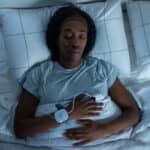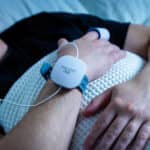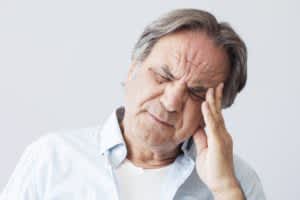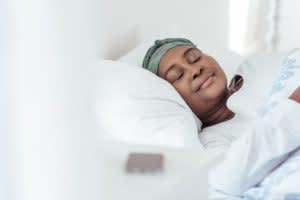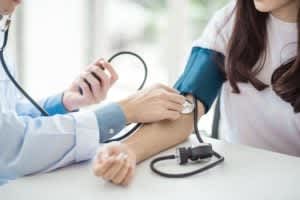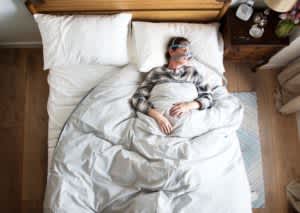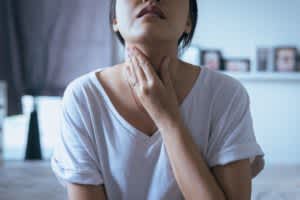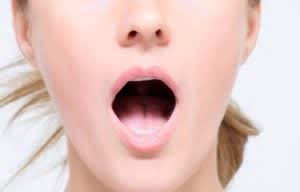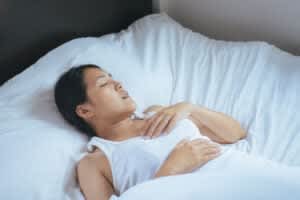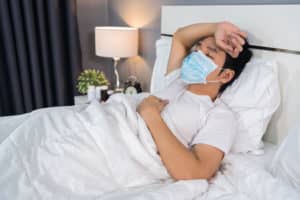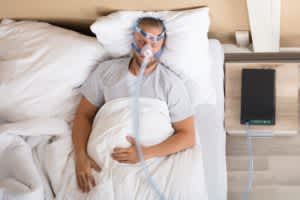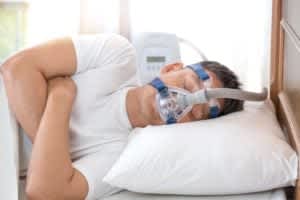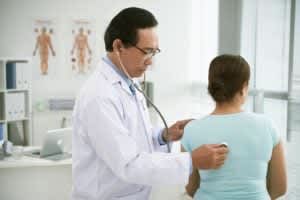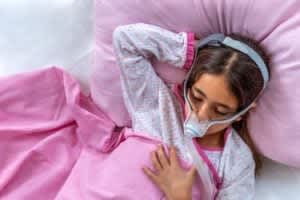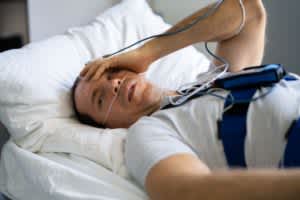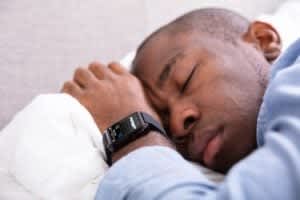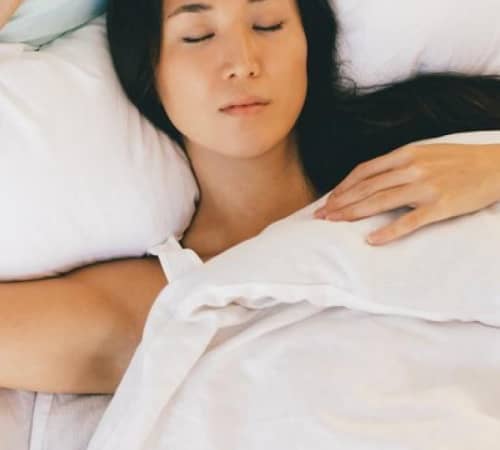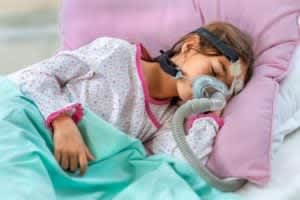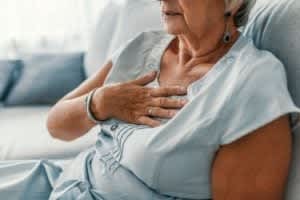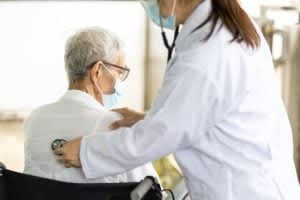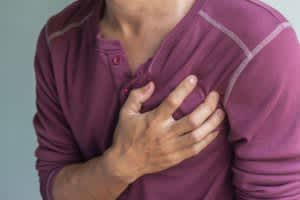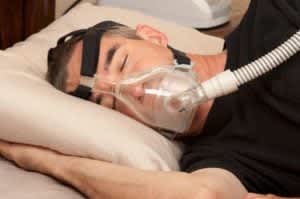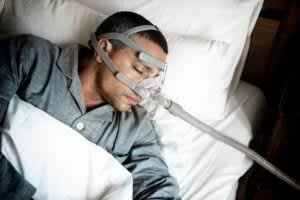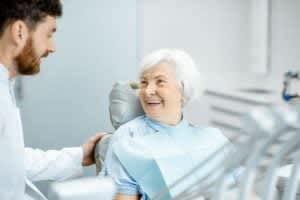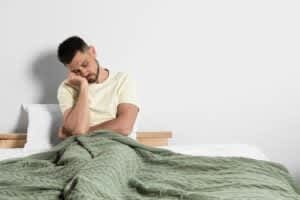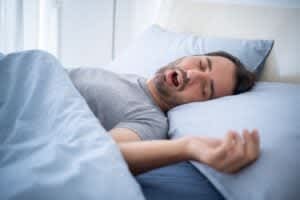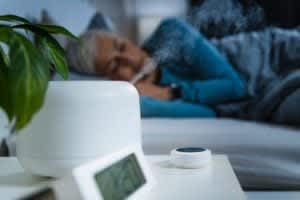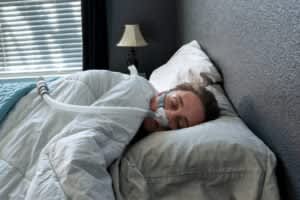When you buy through our links, we may earn a commission. Products or services may be offered by an affiliated entity. Learn more.
Sleep Apnea
What it is, its risk factors, its health impacts, and how it can be treated
- Sleep apnea is a breathing disorder that causes repeated lapses in breathing during sleep.
- Symptoms of sleep apnea can include snoring, headaches, and excessive sleepiness.
- Obstructive sleep apnea occurs when throat muscles reduce space for air to pass through.
- A home sleep test can help you determine if you meet the criteria for a sleep apnea diagnosis.
Sleep apnea is a common sleep disorder that causes frequent pauses in breathing during sleep. Most people with sleep apnea experience symptoms such as loud snoring and daytime sleepiness. The two main types of sleep apnea are obstructive sleep apnea (OSA) and central sleep apnea (CSA).
In OSA, a narrowing of the airway during sleep leads to breathing disruptions. In CSA, the breathing disruptions are caused by a lack of communication between the brain and the muscles involved in breathing.
These breathing interruptions reduce the quality of sleep and, if left untreated, can lead to potentially serious health consequences. It’s critical to work with a doctor if you think you may be at risk for sleep apnea so that you can get any necessary testing and treatment.
Is Your Snoring a Health Risk?
Answer three questions to understand if you should be concerned.
What Is Sleep Apnea?
Sleep apnea is a type of sleep-related breathing disorder, a group of sleep disorders characterized by abnormal breathing patterns during sleep.
People with sleep apnea repeatedly have reductions or pauses in breathing for brief periods while they sleep. Although these lapses cause a person to awaken periodically and reduce sleep quality, sleepers may not fully wake up and remain unaware that their nighttime breathing is abnormal.
There are several types of sleep apnea, categorized by the cause of breathing disruptions.
Obstructive Sleep Apnea
Obstructive sleep apnea (OSA) occurs when the airway at the back of the throat becomes constricted or blocked during sleep, which may cause snoring as air is prevented from passing through normally. In response to the airway obstruction, a person usually wakes up, engages the muscles in their throat, and takes several gasps or deep breaths, often accompanied by sounds like snorting or choking.
Obstructive sleep apnea is the most common type of sleep apnea. It is estimated to affect 10% to 30% of adults in the United States but in many cases goes undiagnosed.
Central Sleep Apnea
Central sleep apnea (CSA) involves disruption in the communication between the brain and the muscles that control breathing . As a result, breathing may become shallower and have temporary pauses.
The prevalence of central sleep apnea is low compared to obstructive sleep apnea. It is estimated that less than 1% of people have CSA.
Symptoms of Sleep Apnea
The symptoms of sleep apnea include the effects of abnormal nighttime breathing, as well as the daytime effects of reduced sleep quality.
Symptoms of Obstructive Sleep Apnea
Frequent symptoms of obstructive sleep apnea include:
- Excessive daytime sleepiness
- Loud snoring that is often punctuated by gasping or choking sounds
- Headaches in the morning that may persist for several hours after waking up
- Dry mouth upon awakening
- Restless sleep with periods of wakefulness during the night
- Increased need to get up from bed to urinate
- Irritability or frustration
- Reduced focus
Certain symptoms of obstructive sleep apnea may not be immediately noticeable to the person with the condition. For example, abnormal breathing and snoring may only come to a person’s attention after they are observed by a bed partner.
Many of the symptoms of obstructive sleep apnea can also be caused by other health issues, so the condition cannot be diagnosed by symptoms alone.
Symptoms of Central Sleep Apnea
The symptoms that are most often associated with central sleep apnea include:
- Abnormal breathing patterns , such as breathing that slows down, speeds up, and pauses during sleep
- Excessive daytime sleepiness
- Nighttime awakenings
- Sudden shortness of breath or chest pains at night
- Difficulty focusing
- Morning headaches
As with obstructive sleep apnea, it is normal for people with central sleep apnea to be unaware of their irregular breathing during sleep unless they are pointed out by a bed partner or caregiver.
Causes of Sleep Apnea
The cause of breathing disruptions differs between obstructive sleep apnea and central sleep apnea.
Causes of Obstructive Sleep Apnea
In people with obstructive sleep apnea, the muscles in the back of the throat relax during sleep, reducing space for air to pass through. Snoring occurs as the airway narrows, and when the airway is obstructed, a person fails to get enough oxygen. The lack of oxygen causes partial or complete awakenings in order to restore airflow. These breathing disruptions happen repeatedly during sleep.
Causes of Central Sleep Apnea
Central sleep apnea arises because of problems in how the brain communicates with the muscles responsible for breathing. For people with CSA, a part of the brain called the brain stem fails to properly recognize carbon dioxide levels in the body during sleep. This leads to repeated episodes of breathing that is slower and shallower than it should be.

Risk Factors for Sleep Apnea
Multiple factors affect a person’s chances of developing sleep apnea, and those factors are different for OSA and CSA.
Risk Factors for Obstructive Sleep Apnea
The primary risk factors for obstructive sleep apnea are related to age, sex, body weight, and certain anatomical features of the head and neck area.
- Age: The risk of developing obstructive sleep apnea increases with age until a person is in their 60s and 70s.
- Sex: Men or people assigned male at birth are generally more likely to have obstructive sleep apnea, especially in the earlier stages of adulthood.
- Head and neck anatomy: Obstructive sleep apnea occurs more frequently in people who have specific anatomical features including a larger tongue and a shorter lower jaw.
- Body weight: Multiple studies have found a correlation between a higher body mass index (BMI) and an elevated risk of developing obstructive sleep apnea.
Studies have identified associations between various other factors and an increased likelihood of having OSA, but further research is needed to clarify their effect on the development of OSA.
- Cigarette smoking: Some research has found a noticeably higher risk of obstructive sleep apnea in people who smoke cigarettes compared to people who have quit or never smoked.
- Hormone abnormalities: Hormone conditions like an underactive thyroid or excess production of growth hormone may increase the risk of OSA by causing swelling of tissue near the airway or by contributing to a higher body mass index.
- Sleeping position: Sleep apnea may develop or be worsened when people sleep on their back because of how that sleeping position affects the shape and positioning of the tissue around the airway.
- Family history of sleep apnea: There are some indications that a family history of OSA can increase a person’s risk of obstructive sleep apnea, which may relate to anatomical features in the head and neck that are shared among family members.
- Nasal congestion: Difficulty breathing through the nose has been linked with a higher likelihood of having OSA.
- Using alcohol and some medications: Alcohol and some prescription and narcotic drugs are associated with an elevated risk of obstructive sleep apnea.
- Certain medical conditions: People with some medical problems, including several heart and lung conditions, may have a greater tendency to develop OSA.
Risk Factors for Central Sleep Apnea
Central sleep apnea most often occurs as a consequence of another medical problem, such as an infection or injury affecting the brain stem , heart or kidney failure, stroke, or excess growth hormone production. Studies have identified some additional factors that are linked with a heightened risk of central sleep apnea.
- Age: People who are over age 65 have a heightened risk of breathing disruptions consistent with central sleep apnea.
- Sex: Central sleep apnea is more common in men or people assigned male at birth, which may be related to levels of certain sex hormones.
- Use of certain drugs: Chronic use of opioid drugs and some prescription medications can affect breathing and have been associated with a higher risk of CSA.
- Being at high altitude: Spending time at high-altitude is associated with CSA because of the decreased availability of oxygen in high-altitude environments.
Think You May Have Sleep Apnea? Try an At-Home Test

our partner at sleepdoctor.com
Save 54% on your Sleep Test Today
Shop Now“Truly grateful for this home sleep test. Fair pricing and improved my sleep!”
Dawn G. – Verified Tester
How Is Sleep Apnea Diagnosed?
Sleep apnea must be diagnosed by a doctor or sleep specialist, and there are several steps in the diagnostic process.
Health History and Physical Exam
An evaluation for sleep apnea typically starts with a review of a person’s symptoms and overall health, as well as a physical exam. This is designed to detect signs of sleep apnea and identify risk factors that could contribute to the condition.
Although testing is required to confirm that someone has OSA, the presence of symptoms can factor into the diagnosis and help determine the severity of the condition.
Sleep Study
A sleep study is necessary to diagnose obstructive or central sleep apnea. The most dependable kind of sleep study is called polysomnography, which is conducted during an overnight stay at a specialized sleep laboratory.
During polysomnography, multiple sensors are used to track breathing, awakenings, oxygen levels, muscle movement, sleep stages, and other aspects of sleep. An in-clinic sleep study can determine if breathing is abnormal and differentiate between obstructive and central sleep apnea. For OSA, polysomnography may involve either one or two visits to a sleep clinic.
An at-home sleep study for obstructive sleep apnea is an option for certain patients who are believed to have more severe OSA. Taking an at-home sleep apnea test may be more convenient, but the results must still be interpreted by a health professional. Home testing is not used for central sleep apnea.
Treatments for Sleep Apnea
The goal of treatment for sleep apnea is to reduce breathing disruptions and improve sleep. The approach to treatment varies between obstructive sleep apnea and central sleep apnea.
Treatments for Obstructive Sleep Apnea
Positive airway pressure (PAP) therapy is a treatment offered to almost all people with obstructive sleep apnea. PAP therapy keeps the airway open with pressurized air that is pumped from a machine through a hose and a mask worn on the face.
A common type of PAP therapy uses a continuous positive airway pressure (CPAP) device that sends a stream of air that is always set to the same pressure level. Other types of PAP devices, such as bi-level positive airway pressure (BiPAP) and auto-titrating positive airway pressure (APAP), provide variability in the amount of air pressure.
Some types of mouthpieces that hold the jaw or tongue in a specific position are a treatment option for people with certain anatomical features and less severe OSA. These oral appliances often do not improve breathing as much as PAP therapy, but they can reduce snoring and may be preferred by people who have difficulties or discomfort when using PAP devices.
Surgery to remove tissue in the throat and expand the airway can be a treatment option for patients who have tissue obstructing their airway. Another type of surgical treatment requires implanting a device to stimulate a nerve that helps control breathing.
An additional component of treatment for obstructive sleep apnea involves lifestyle changes to help manage symptoms. These suggestions may include:
- Reducing BMI by losing weight
- Getting regular exercise, which may decrease OSA symptoms even without weight loss
- Altering sleeping position to avoid back sleeping
- Reducing alcohol consumption
Treatments for Central Sleep Apnea
Treatment for central sleep apnea often focuses on addressing the medical issue causing abnormal breathing. If sleep disruptions are mild, treatment for the underlying cause may be all that is required.
However, if the symptoms of central sleep apnea are persistent or severe, additional treatment may be recommended to improve breathing while also trying to resolve the underlying problem. This may include the use of PAP devices to promote steadier breathing during sleep. Other possible treatments include supplemental oxygen therapy or use of medication that can speed up a person’s breathing .
Complications of Sleep Apnea
Effective treatment can generally prevent or resolve serious complications from sleep apnea, but if the condition is left untreated, it can have far-reaching effects on health and well-being.
Sleep apnea reduces sleep quality, and the effects of poor sleep are compounded by how sleep apnea affects oxygen levels in the body.
Accordingly, obstructive sleep apnea has been associated with a higher risk of a diverse range of health problems, including:
- Car accidents from drowsy driving
- Cardiovascular diseases like high blood pressure, stroke, heart failure, heart disease, and an abnormal heartbeat
- Metabolic disorders including type 2 diabetes
- Pulmonary hypertension, which is high blood pressure in the arteries of the lungs that places excess strain on the heart
- Thinking problems such as impaired memory and concentration
- Mood disturbances including irritability and a higher risk of depression
- Nonalcoholic fatty liver disease, which is an increase in fat deposits in the liver that can contribute to serious liver damage
- Anesthesia-related complications during surgery
In central sleep apnea, the complications that can occur depend largely on the underlying medical issue causing breathing to be disordered.
Sleep Apnea in Children
Although frequently associated with older adults, sleep apnea can occur in children. In young people, obstructive sleep apnea is much more common than central sleep apnea. It is estimated that 1% to 5% of children have obstructive sleep apnea.
Children with OSA may not experience excessive daytime sleepiness as seen in adults with sleep apnea. Instead, they may exhibit daytime symptoms like hyperactivity, learning difficulties, or behavior problems.
As in adults, snoring is common for children with obstructive sleep apnea. However, children may have other nighttime symptoms like sweating, bedwetting, or sleepwalking. Children with severe untreated OSA may also experience problems with their growth and development.
For many children, obstructive sleep apnea is caused by enlarged tonsils and adenoids in the throat, and surgery to remove these tissues may be an option for treatment.
Living with Sleep Apnea
Practical steps can help people living with sleep apnea to cope with this condition and its potential health effects.
- Work closely with a doctor: It is important to stay in touch with a primary care doctor or sleep specialist and report any ongoing symptoms, challenges with treatment, or other concerns that may require an adjustment to the plan for managing sleep apnea.
- Properly care for treatment devices: Whether using a PAP device or a mouthpiece, cleaning and maintenance can help get the most out of treatment and avoid unwanted side effects.
- Avoid high-risk activities: People with sleep apnea should be aware of the risks of daytime sleepiness. Especially for people with untreated sleep apnea, activities like driving or operating heavy machinery should be avoided when drowsy.
- Consider changing sleeping position: Although they have not been rigorously studied, special products to avoid back sleeping may help some people reduce their symptoms from obstructive sleep apnea.
- Minimize alcohol consumption: Reducing alcohol intake can be a component of the treatment plan for sleep apnea. In people with untreated OSA, even daytime alcohol consumption may exacerbate breathing problems at night.
- Inform new doctors about sleep apnea: People with sleep apnea should mention this condition to any new medical providers, especially when planning to start a new medication or undergo surgery.
References
21 Sources
-
A.D.A.M. Medical Encyclopedia. (2020, January 29). Obstructive sleep apnea – adults. MedlinePlus., Retrieved May 31, 2022, from
https://medlineplus.gov/ency/article/000811.htm -
Kline, L. R. (2022, April 1). Clinical presentation and diagnosis of obstructive sleep apnea in adults. In N. Collop (Ed.). UpToDate., Retrieved May 31, 2022, from
https://www.uptodate.com/contents/clinical-presentation-and-diagnosis-of-obstructive-sleep-apnea-in-adults -
Strohl, K. P. (2020, September). Sleep apnea. Merck Manual Consumer Version., Retrieved May 31, 2022, from
https://www.merckmanuals.com/home/lung-and-airway-disorders/sleep-apnea/sleep-apnea -
Becker, K. (2020, August 25). Central sleep apnea syndromes. Medscape., Retrieved May 31, 2022, from
https://emedicine.medscape.com/article/304967-overview -
Strohl, K. P. (2020, September). Obstructive sleep apnea. Merck Manual Professional Version., Retrieved May 31, 2022, from
https://www.merckmanuals.com/professional/pulmonary-disorders/sleep-apnea/obstructive-sleep-apnea -
Strohl, K. P. (2020, September). Central sleep apnea. Merck Manual Professional Version., Retrieved May 31, 2022, from
https://www.merckmanuals.com/professional/pulmonary-disorders/sleep-apnea/central-sleep-apnea -
Badr, M. S. (2021, September 30). Central sleep apnea: Risk factors, clinical presentation, and diagnosis. In R. D. Chervin (Ed.). UpToDate., Retrieved May 31, 2022, from
https://www.uptodate.com/contents/central-sleep-apnea-risk-factors-clinical-presentation-and-diagnosis -
Vouzouneraki, K., Franklin, K. A., Forsgren, M., Wärn, M., Persson, J. T., Wik, H., Dahlgren, C., Nilsson, A. S., Alkebro, C., Burman, P., Erfurth, E. M., Wahlberg, J., Åkerman, A. K., Høybye, C., Ragnarsson, O., Engström, B. E., & Dahlqvist, P. (2018). Temporal relationship of sleep apnea and acromegaly: A nationwide study. Endocrine, 62(2), 456–463.
https://pubmed.ncbi.nlm.nih.gov/30066288/ -
Kryger, M. H., & Malhotra, A. (2022, May 23). Management of obstructive sleep apnea in adults. In N. Collop (Ed.). UpToDate., Retrieved May 31, 2022, from
https://www.uptodate.com/contents/management-of-obstructive-sleep-apnea-in-adults -
A.D.A.M. Medical Encyclopedia. (2021, July 12). Central sleep apnea. MedlinePlus., Retrieved May 31, 2022, from
https://medlineplus.gov/ency/article/003997.htm -
Gallagher, S. A., Hackett, P., Rosen, J. M. (2022, February 11). High altitude illness: Physiology, risk factors, and general prevention. In D. F. Danzl (Ed.). UpToDate., Retrieved May 31, 2022, from
https://www.uptodate.com/contents/high-altitude-illness-physiology-risk-factors-and-general-prevention -
A.D.A.M. Medical Encyclopedia. (2020, January 29). Positive airway pressure treatment. MedlinePlus., Retrieved May 31, 2022, from
https://medlineplus.gov/ency/article/001916.htm -
Cistulli, P. A. (2022, March 31). Oral appliances in the treatment of obstructive sleep apnea in adults. In N. Collop (Ed.). UpToDate., Retrieved May 31, 2022, from
https://www.uptodate.com/contents/oral-appliances-in-the-treatment-of-obstructive-sleep-apnea-in-adults -
Schmickl, C. N., Landry, S. A., Orr, J. E., Chin, K., Murase, K., Verbraecken, J., Javaheri, S., Edwards, B. A., Owens, R. L., & Malhotra, A. (2020). Acetazolamide for OSA and central sleep apnea: A comprehensive systematic review and meta-analysis. Chest, 158(6), 2632–2645.
https://pubmed.ncbi.nlm.nih.gov/32768459/ -
Mehra, R. (2021, August 25). Obstructive sleep apnea and cardiovascular disease in adults. In N. Collop (Ed.). UpToDate., Retrieved May 31, 2022, from
https://www.uptodate.com/contents/obstructive-sleep-apnea-and-cardiovascular-disease-in-adults -
A.D.A.M. Medical Encyclopedia. (2020, January 1). Pulmonary hypertension. MedlinePlus., Retrieved May 31, 2022, from
https://medlineplus.gov/ency/article/000112.htm -
A.D.A.M. Medical Encyclopedia. (2021, April 22). Nonalcoholic fatty liver disease. MedlinePlus., Retrieved May 31, 2022, from
https://medlineplus.gov/ency/article/007657.htm -
Constantin, E., Brouillette, R. T. (2022, February 18). Congenital central hypoventilation syndrome and other causes of sleep-related hypoventilation in children. In R. D. Chervin (Ed.). UpToDate., Retrieved May 31, 2022, from
https://www.uptodate.com/contents/congenital-central-hypoventilation-syndrome-and-other-causes-of-sleep-related-hypoventilation-in-children -
Paruthi, S. (2022, April 15). Evaluation of suspected obstructive sleep apnea in children. In R. D. Chervin. (Ed.). UpToDate., Retrieved May 31, 2022, from
https://www.uptodate.com/contents/evaluation-of-suspected-obstructive-sleep-apnea-in-children -
A.D.A.M. Medical Encyclopedia. (2021, August 10). Pediatric sleep apnea. MedlinePlus., Retrieved May 31, 2022, from
https://medlineplus.gov/ency/article/007660.htm -
Strohl, K. P. (2020, September). Obstructive sleep apnea in children. Merck Manual Professional Version., Retrieved May 31, 2022, from
https://www.merckmanuals.com/professional/pulmonary-disorders/sleep-apnea/obstructive-sleep-apnea-in-children


